Jazz Bands in 1926 – A political and social history.
In 1926, the country experienced a bitter general strike followed, in some areas, by a longer lock-out in the coal industry.
The event is recalled by Idris Davies, the Welsh miner, turned poet who wrote:
Do you remember 1926? That summer of soups and speeches.
. . . . . Do you remember 1926? The slogans and the penny concerts, The Jazz-bands and the moorland picnics. (Gwalia Deserta, VIII).
The line not only refers to the strike and lock-out, but to the multitude of jazz and character bands that were formed in the south Wales valleys to boost morale and raise money to alleviate the hardship of the families of those involved.
These experiences were all too real in the Cynon valley and are tangibly recollected in the museum by an item of clothing.

Male white cotton short Bolero jacket and trousers. The jacket has red lapels and cuffs. The costume was worn by David Charles Huntley, a member of the Victoria Street Band, Miskin, Mountain Ash. Location: Main Gallery. Image taken by CVM staff.
This rare and evocative object from the collection is an original costume worn by a band member. The band’s principal instrument was the gazooka or gazoot, a tin cigar-shaped instrument, which produced a distinctive but monotonous sound by anyone capable of humming.
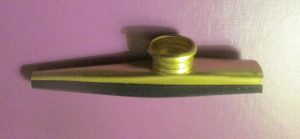
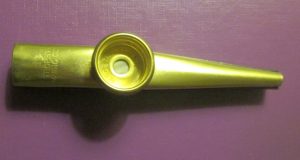
The gazoot. Stiff paper cones were added to increase the volume of the sound. Images by Geoffrey Evans.
The cabinet in the museum also contains a variety of percussion instruments and other props commonly used.
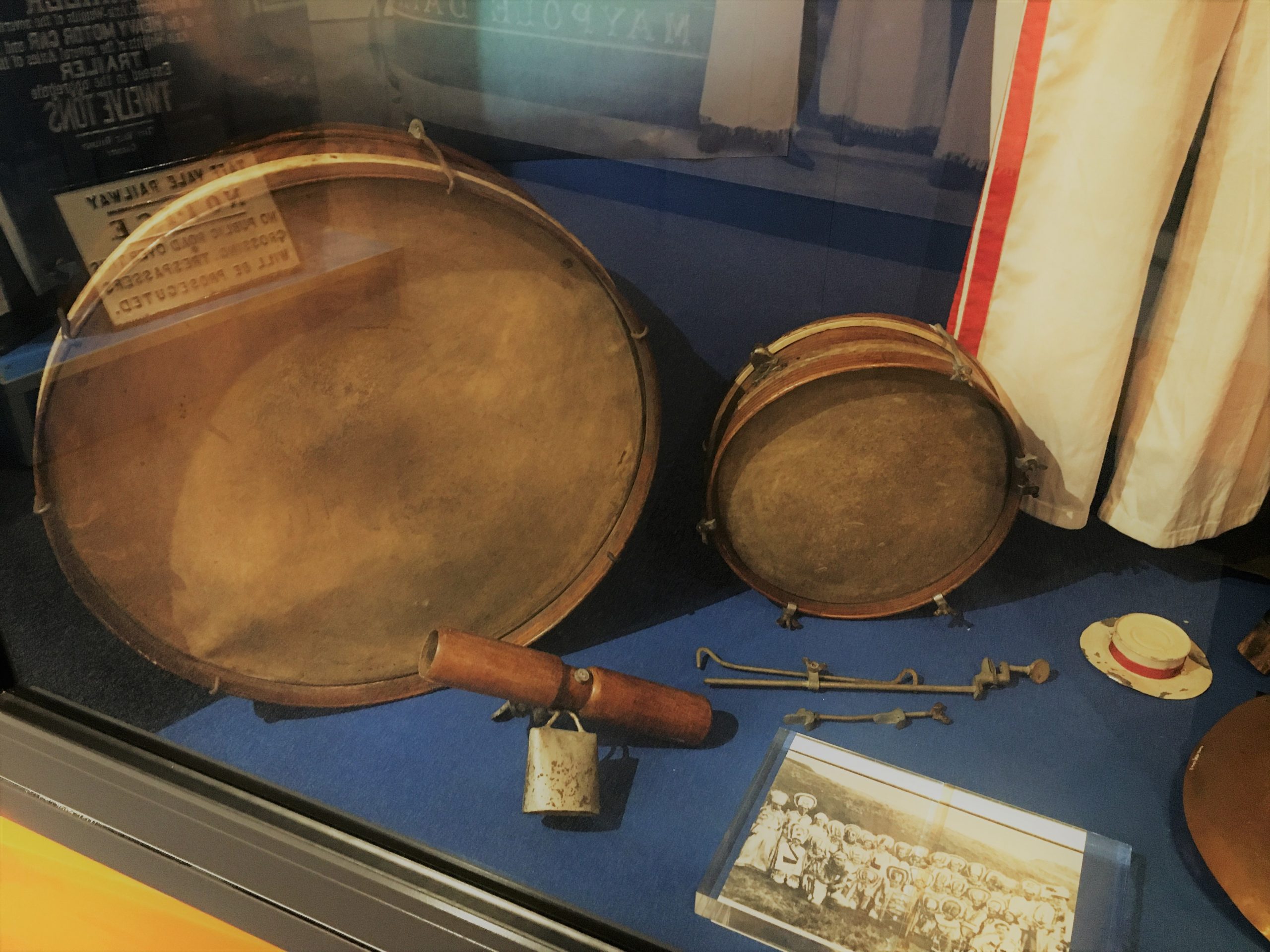
Drum kit, Cwmbach Ladies Jazz Band, 1926 Lockout. Used by Esther Ann Lewis, the bandleader. Location: Main Gallery. Image taken by CVM staff.
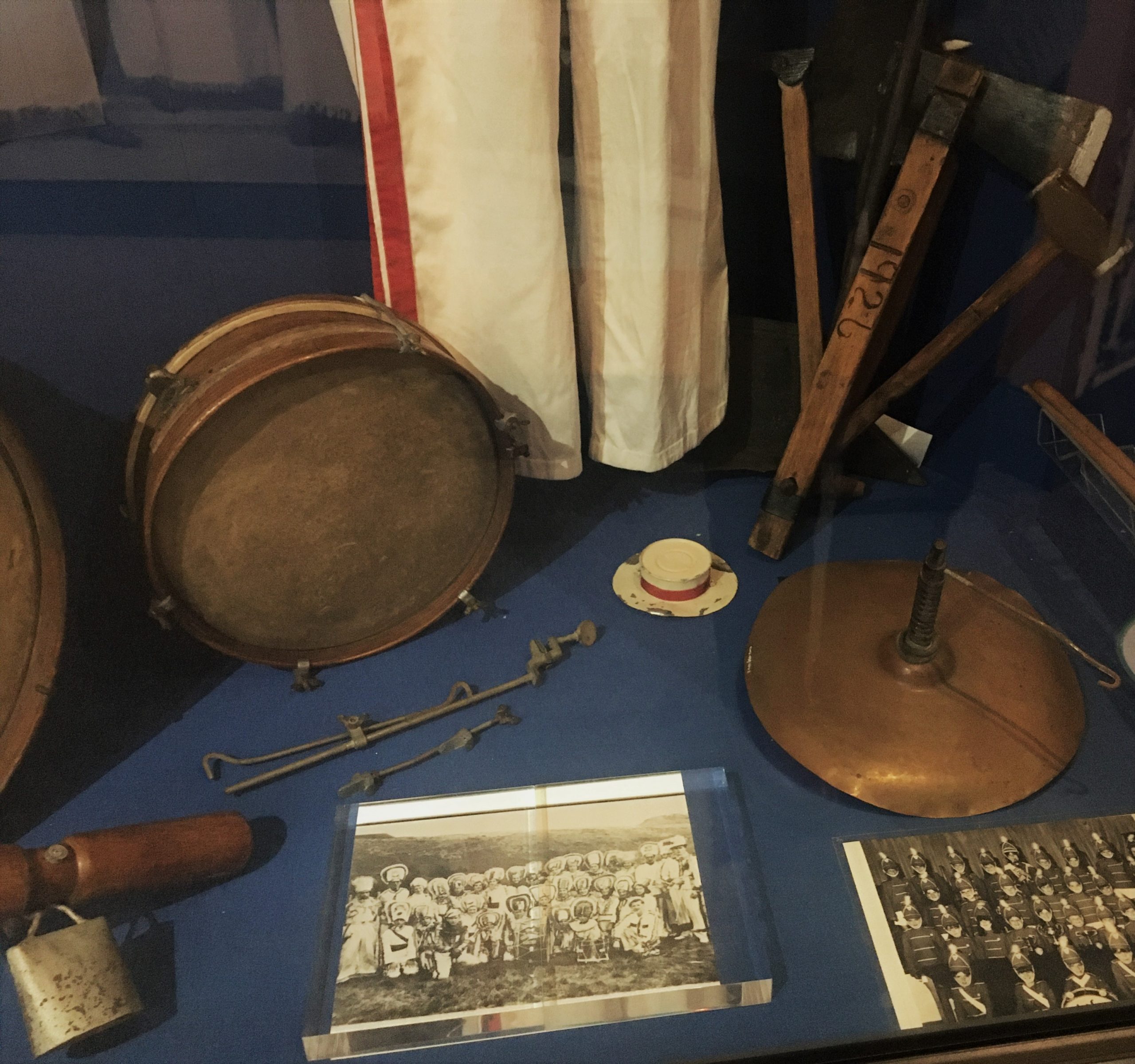
Miniature wooden miner’s tool set, carried by jazz band mascot during the 1926 Strike. Location: Main Gallery. Image taken by CVM staff.
In the Aberdare valley alone there were 60 jazz bands and 30 character bands.
Their costumes, of great variety, would have been patiently and lovingly made by the bandsmen, their wives and families. The one on display in our gallery is very professionally made. The jazz-bands had exotic names such as the Cwmbach Nutcrackers, the Bonky Boys, Egyptian Priests (a character band) and Napier’s Black Watch. Unfortunately, a number chose names that don’t bear repeating today due to their discriminatory and racist nature. There were also a number of women’s bands.
Individual bands had to be inventive in the making of their costumes. Edwin Greening recalls that the tall straw sombreros of the 40 strong Club Street Mexican Band were made out of fish frails and plaited straw baskets donated by three local shop owners.
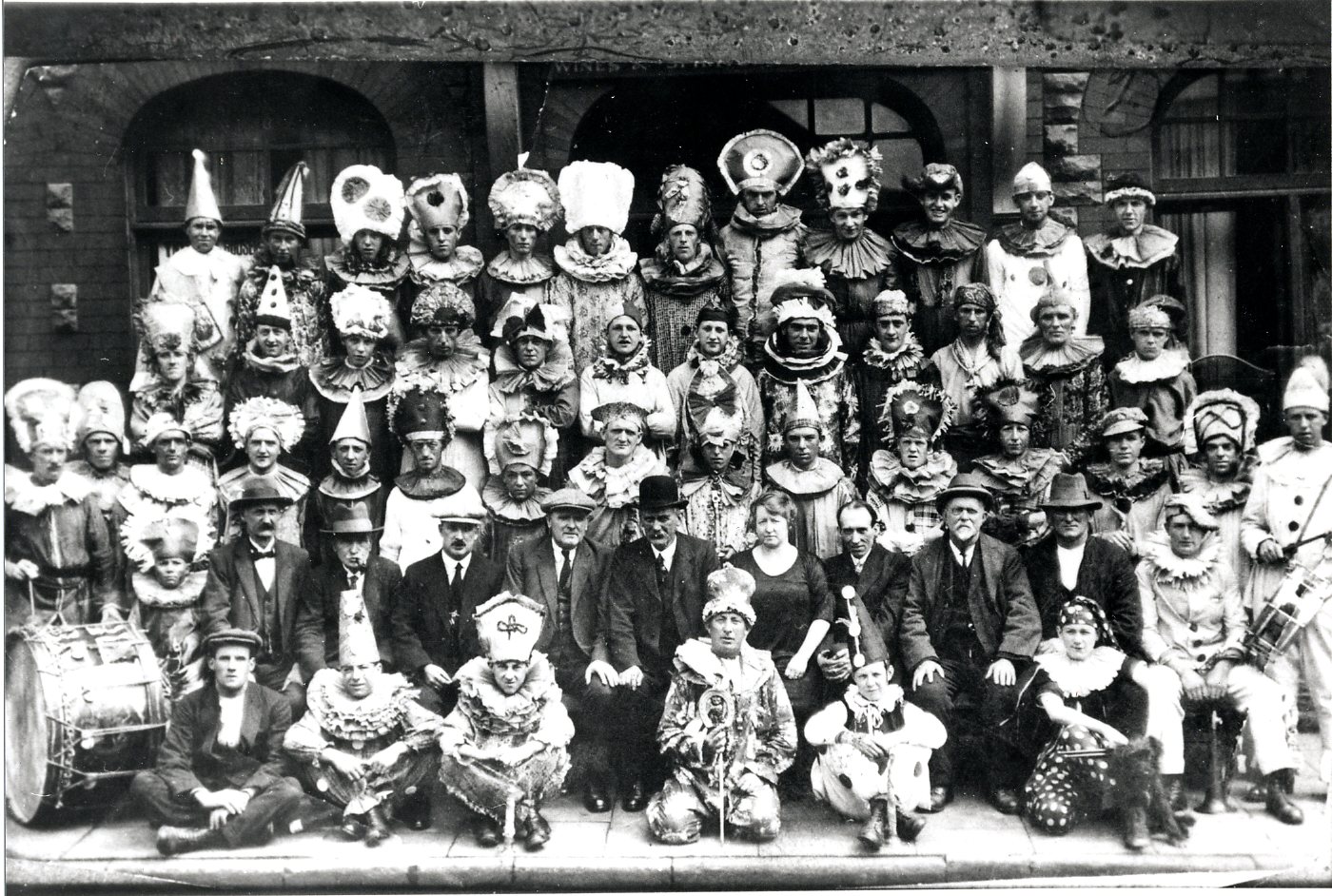
Image ACVMS 2009.228. The Aberaman New Inn Jazz Band. The band wears Pierrot costumes, with fantastic hats – a cross between tea cosies and bishop’s mitres.
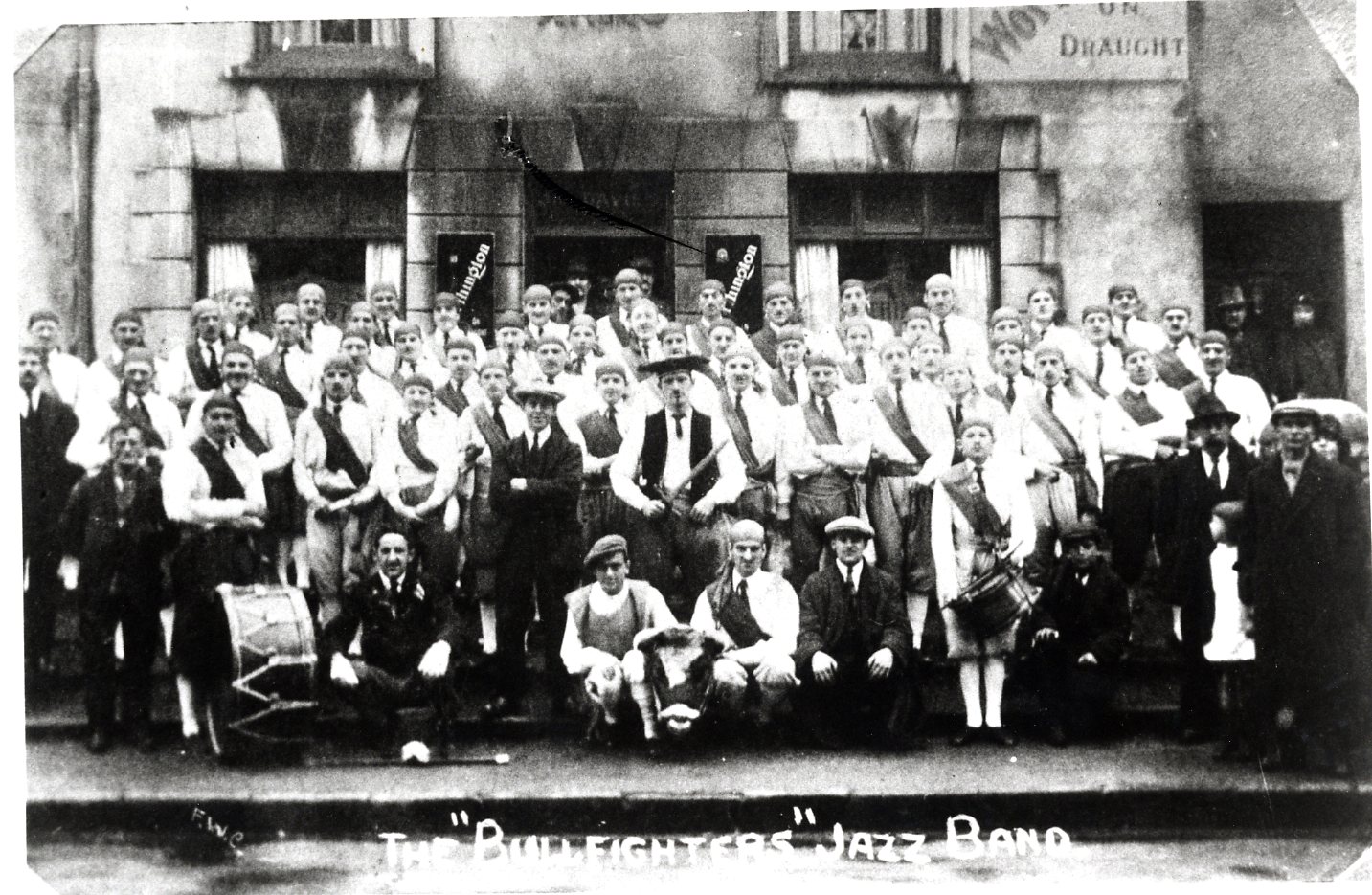
Image ACVMS 2009.208. The Bull Fighters at the Fforchneol Arms, Cwmaman. The two men in the centre of the front row support a ‘bulls head’ and ‘the matador’, wooden sword in hand, stands behind.
The bands would parade the streets with collecting boxes and compete with each other for prizes at local carnivals. Many of the bands would walk many miles on their ‘hunger marches’ and to competitions, and it is on record that bands from Aberdare walked over the mountains to Porth and back.
The working of a jazz-band is recollected by the late Desmond Edmunds of Cwmdare (in Walkers in the Streets, an unpublished work).
‘The famous jazz-band movement played a part in the suppression of violence during the 1926 miner’s strike. The Cwmdare band for instance was a marching- band consisting of a long column of men each carrying the standard instrument, the tin gazoot, these were very cheap and very popular. I think most children had a gazoot. I know we did. Then there were a pair of [side] drums, and finally a big drum, which in our band was handled by a big strong man named Jack Hooker.
In the early days before regional competitions imposed uniformity, the costumes were multi coloured patch work, all homemade, with wide ruffs, white gloves and fancy headgear of all shapes and sizes. The gazoots were fixed into prettily coloured decorated cones, and the drums were draped with ribbons and skins. The leader manipulated a fine long staff and was obviously a person of considerable importance. Training, both musical and in marching was most rigorous. In our case the latter was the province of the village ‘bobby’, PC Bendall, who in short sleeves in the schoolyard, barked out his commands until the steps and intricate patterns were perfected. The co-opting of the police in this way was clearly a shrewd move, and an excellent example of identification with the community. It was of course quite thrilling to watch the band procession in full tilt, with our signature tune Moonlight and Roses, stride its way gaily and colourfully in public display along the streets.’
The lock-out lasted 7 months from June to December and has been described as a great watershed in the economic life of the Aberdare valley.
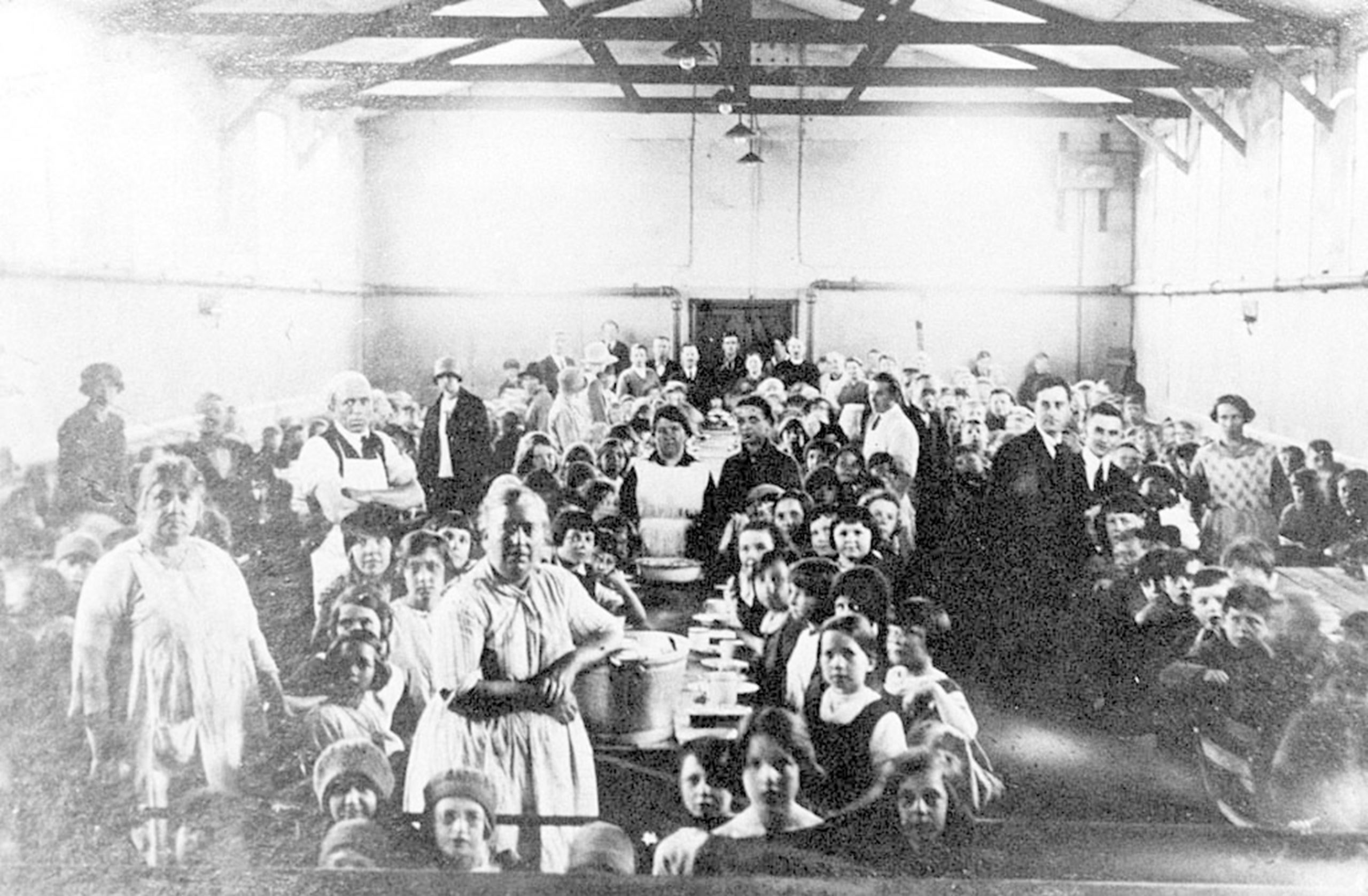
Image 31/b/070 Soup Kitchen for Hirwaun schoolchildren during the 1926 coal strike. Image reproduced by kind permission from Rhondda Cynon Taf Libraries.
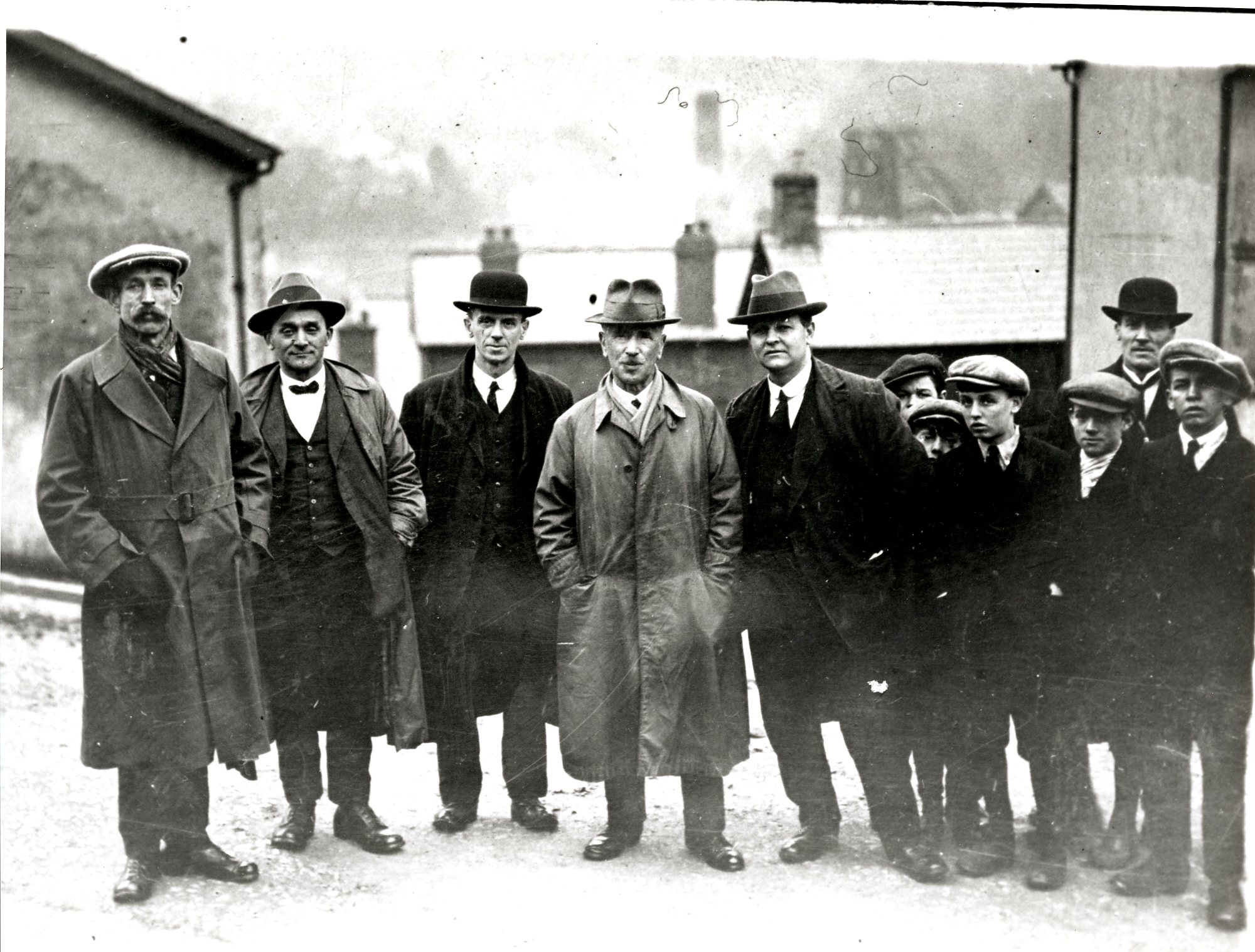
Image ACVMS 1997.2775. Soup kitchen organisers. George Hall MP (later The Viscount Hall of Cynon Valley) is the fifth man from the left. Location: The Pavilion, Mountain Ash.
However, it was ultimately a victory for the mine owners and the colliers were obliged to return to work and accept a 20% reduction in wages and an 8 hour day. An experience which Idris Davies described as a ‘great dream and swift disaster.’
In the Aberdare valley in 1926, 22,000 miners were still employed at 42 collieries owned by 9 colliery companies.
Blog post written by volunteer, Geoffrey Evans, January 2021.
This blog has been possible thanks to funding from National Lottery Heritage Fund.
SOURCES AND FURTHER READING:
Meic Stephens (Ed): The Oxford Companion to the Literature of Wales, p.290. OUP, 1986.
Greening, Edwin: A Collier Boy in the 1926 Coal Lock-Out. Old Aberdare, Vol. Eight, Neath, 1997, pp 1-23. A definitive account of life in Aberdare in the year 1926.
Hanes: Number 35, Summer, 2006. Cynon Valley History Society.
Thomas, Gwyn: Gazooka, a collection of short stories, London, Gollancz, 1957.
Rhondda Cynon Taf Library Service Digital Archive, https://archive.rctcbc.gov.uk/home?WINID=1612866957168
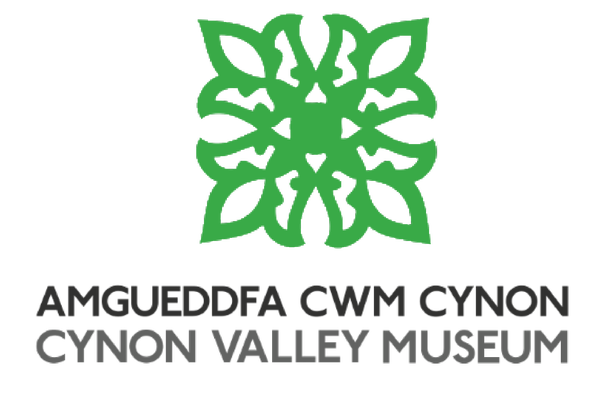
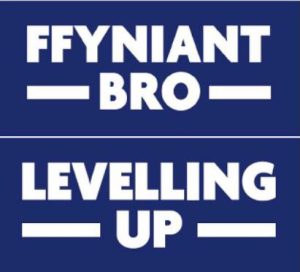


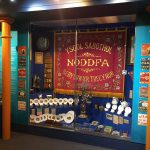
I have much enjoyed reading Geoffrey Evans’s latest illustrated essay, ‘Jazz Bands of The South Wales Valleys’. How hard he works, at research and writing and on such a variety of topics, too. Geoffrey is an unsung hero of these Covid times, delivering cheer to so many of us as we endure the miseries of seemingly unending lockdowns. I was especially pleased to see that two of the illustrations used here are postcards.
Given the passing of time, there can be no adults alive now who marched, banged drums or blew gazoots in 1926. However, I wonder if, during lockdown days and weeks, anyone spent time tidying up cupboards, sorting out drawers even going up into the attic to see what might have been put there years ago, and forgotten. Possibly, interesting odds and ends were found which might have rekindled memories.
‘This was Dad’s Jazz Band outfit.’
‘Grampa’s marked with a cross on this postcard. Fancy him being a matador!’
‘Well, well, Uncle Jack’s gazoot! I wondered where that had gone.’
I’m sure that those memories, written down, would be warmly welcomed at the museum and added to the splendid archive stored there.
‘I must have been about ten when Dad told me about the time he was a Jazz Band member, in 1926. It’s a pity that he didn’t himself write down what he told me, but this is what I remember him saying …”
Better, if there are odds and ends of interest that the descendants of Jazz Band members have at home but no longer wish to keep, I’m sure that the museum would welcome such items as donations to the museum’s collection. They’d be preserved by professional curators, stored carefully and may even be displayed in the show-cases in the museum’s galleries, all donations being acknowledged appropriately.
How pleased ‘Dad’, ‘Grampa’ and ‘Uncle Jack’ would be to know that though they’ve gone, they haven’t been forgotten.
How satisfying to the descendants of every family’s ‘Dad’, ‘Grampa’ and ‘Uncle Jack’, to know that their little bit of family history will be a cherished part of the history of our valley, so well portrayed in the Cynon Valley Museum.
It takes only a few minutes to read Geoffrey’s essay, which may be read again, and as many times as a reader might wish, for it’s part of the excellent and on-going ‘Stories from the Collection’ series.
But if Geoffrey’s essay prompted donations to the museum, what a great bonus that would be for us all.
Thank you Geoffrey, for a fine essay.
Gareth Thomas, (Abercwmboi).
An interesting and informative article from Geoff Evans. My father, whom Geoff might remember, was a member of “The Strutters”, a minstrel band which would be considered very politically incorrect now, but was thought acceptable during the 1920s.
I remember my grandfather’s costume that was shown to us many times when we were children and stories told of my grandfather Albert Bowen being in a Jazz band in Llanelly, Carmarthenshire at about that time he was born in 1900, he had a gazoot, it was one that must have been home made of what looked like wood! It looked a little like the shape of a sort of submarine with holes in the top if I remember correctly, whatever happened to it I wonder! his costume was black velvet mostly and white and I think red but not too sure, a little waistcoat and the hat was a black velvet rather like a rather large type of beret but fancy and I think lace on it, I have been trying to find a photo of them on the internet but no luck so far, it was obviously a very treasured memory of his as it was told to me with relish many times.